After hours navigating Brazil’s Pantanal wetlands in search of jaguars earlier this month, Daniel Moura beached his boat to survey the fire damage. In every direction, he saw only devastation. No wildlife, and no support from federal authorities.
“We used to see jaguars here all the time; I once saw 16 jaguars in a single day,” Moura, a guide who owns an eco-tourism outfit, said on the riverbank in the Encontro das Aguas state park, which this year saw 84% of its vegetation destroyed.
“Where are all those animals now?”
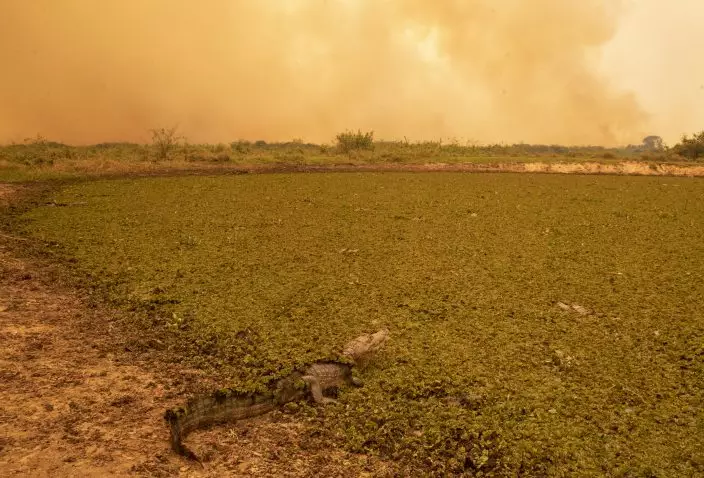
A caiman sits in a field of green as a fire consumes an area next to the Trans-Pantanal highway in the Pantanal wetlands near Pocone, Mato Grosso state, Brazil, Friday, Sept. 11, 2020. Jair Bolsonaro’s government says it has mobilized hundreds of federal agents and military service members to the region to douse the flames. However, all along the only highway through the northern Pantanal, dozens of people — firefighters, ranchers, tour guides and veterinarians — told The Associated Press that the government has exaggerated its response and there are few federal boots on the ground. (AP PhotoAndre Penner)
The world’s largest tropical wetlands, the Pantanal is popular for viewing the furtive felines, along with caiman, capybara and more. This year it is exceptionally dry and burning at a record rate. The fires have been so intense that at one point smoke reached Sao Paulo, 900 miles away.
President Jair Bolsonaro’s government says it has mobilized hundreds of federal agents and military service members to douse the flames. However, all along the only highway through the northern Pantanal, dozens of people — firefighters, ranchers, tour guides and veterinarians — told The Associated Press the government has exaggerated its response and there are few federal boots on the ground.
What little concrete assistance has come mostly from planes dropping water from above, locals said, but that only happened after great delay and mainly targeted private ranches rather than protected areas. Making matters worse, several aircraft remained grounded at the start of the inferno.
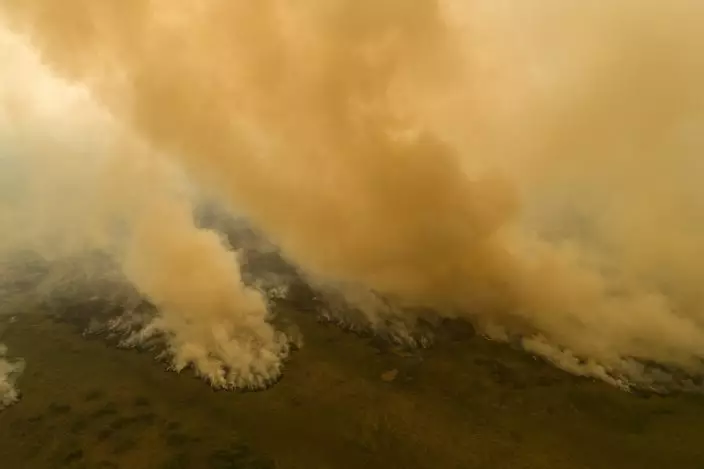
Fire consumes an area next to the Trans-Pantanal highway in the Pantanal wetlands near Pocone, Mato Grosso state, Brazil, Friday, Sept. 11, 2020. Diminished visibility from fires in the Pantanal and the neighboring Amazon forced President Jair Bolsonaro's plane to abandon a Sept. 18 landing attempt in the state of Mato Grosso. (AP PhotoAndre Penner)
“I can’t see much federal help; it is basically us here,” said Felipe Augusto Dias, executive director of SOS Pantanal, an environmental group.
Both sides of the Trans-Pantanal highway — an area that should feature pools of water, even in its dry season — was parched. As of Sunday, nearly a quarter of the Pantanal — an area more than the size of Maryland — had been consumed by fire, according to satellite imagery from the Federal University of Rio de Janeiro. Pantanal vegetation can regenerate quickly with rain, but the wildlife that survive are left stranded without habitat.
Along that scorched landscape were injured and disoriented animals, plus charred corpses of others. On the river, Moura motored past a dead 6-foot-long anaconda, tangled on a fallen tree branch. A fawn, lost and alone amid burned shrubs, eyed the boat. The sky was an apocalyptic orange.

Daniel Moura, an eco-tourism guide, rides his boat on the Cuiaba river as fires burn in the Encontro das Aguas Park near Pocone, Mato Grosso state, Brazil, Saturday, Sept. 12, 2020. The Pantanal, the world’s largest tropical wetlands and a biodiversity hot spot, this year is exceptionally dry and burning at a record rate. (AP PhotoAndre Penner)
Pantanal fires began burning wildly in July and continued into September. The number of fires so far this year — more than 17,000 — exceeds the 12-month totals for every year on record, stretching back to 1998, and is triple the annual average, according to data from the government’s space agency, which uses satellites to count the blazes.
Fires, whether intentionally set or the result of lightning strikes, can easily spiral out of control in the dry season. A Federal Police investigation indicates fires to clear pastures at four ranches spread across 25,000 hectares (almost 100 square miles), detective Alan Givigi said. The wildfire burned preservation areas and a national park.
Addressing the United Nations General Assembly last week, Bolsonaro said Brazil has been targeted by a disinformation campaign, and compared the Pantanal's vulnerability to that of California — without noting that this year's Pantanal wildfires have destroyed an area more than twice the size of California's blazes.

Veterinarian Karen Ribeiro holds a jabiru, while fellow vets examine the injured bird's wing, at a center created for animals injured in the fires in the Pantanal wetlands near Pocone, Mato Grosso state, Brazil, Friday, Sept. 11, 2020. "We feel a little discouraged, but we try to have hope to rescue the few animals we can," said the 26-year-old vet after treating the injured wing of the jabiru, a massive bird that is a symbol of the Pantanal. (AP PhotoAndre Penner)
“Large fires are the inevitable consequences of high local temperature in addition to the accumulation of decomposing organic matter,” he said in his pre-recorded message.
With government agents largely absent, firefighters and volunteers carved firebreaks and used buckets and hoses to battle walls of flames. Along a dirt road off the Trans-Pantanal, a man carrying a basin of water ran from his improvised water truck to a stretch of burning vegetation. It had little effect as wind redirected the flames toward a tree, causing it to explode as though it had been soaked with gasoline.
“The wind changed direction,” Divino Humberto said dejectedly. “It (the fire) is going into the forest.”

A jaguar crouches in an area recently scorched by wildfires at the Encontro das Aguas state park in the Pantanal wetlands near Pocone, Mato Grosso state, Brazil, Sunday, Sept. 13, 2020. The Pantanal is the world’s largest tropical wetlands, popular for viewing the furtive felines, along with caiman, capybara and more. This year the Pantanal is exceptionally dry and burning at a record rate. (AP PhotoAndre Penner)
Brazil’s defense ministry told the AP that numbers vary day to day, but on Sept. 14, the navy had 172 service members in the Pantanal in Mato Grosso, along with 139 federal agents and 11 aircraft. That same day, the Mato Grosso state firefighters corps said the count of navy and agents was only 60, and there was just one plane.
During the five days AP journalists traveled the Pantanal this month, they didn’t see a single member of Brazil’s armed forces.
The defense ministry didn’t respond to AP questions about the disparity between its figures and those from the firefighters.
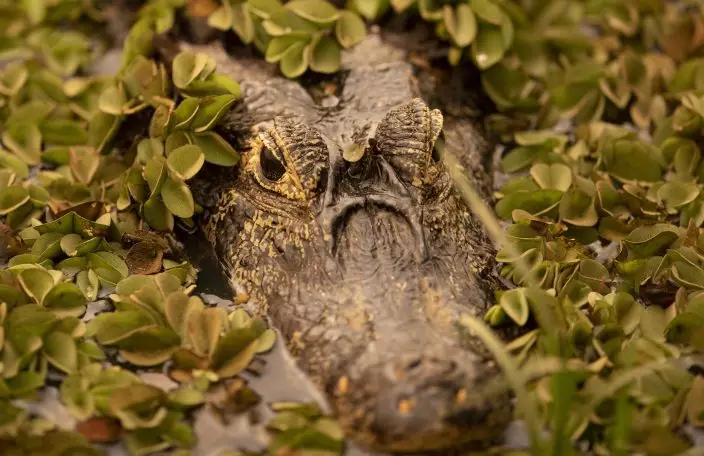
A caiman peeks out from a field of green as a fire consumes an area next to the Trans-Pantanal highway in the Pantanal wetlands near Pocone, Mato Grosso state, Brazil, Friday, Sept. 11, 2020. The Pantanal is the world’s largest tropical wetlands, popular for viewing jaguars, along with caiman, capybara and more. This year the Pantanal is exceptionally dry and burning at a record rate. (AP PhotoAndre Penner)
The Chico Mendes Institute, which administers federal parks for the Environment Ministry, hired five planes to drop water in Mato Grosso, a ministry statement said.
But pilots complained they were denied permission to fly when they arrived in mid-August, when the fires had already been burning for weeks, despite sufficient visibility to do so.
“The pilots said it clearly: If those five planes had fought throughout that week, there wouldn’t have been a big fire,” said Mario Friedlander, an environmentalist and photographer who has worked in the region for 40 years and came to volunteer, told the AP. “The fire would have been drastically controlled.”
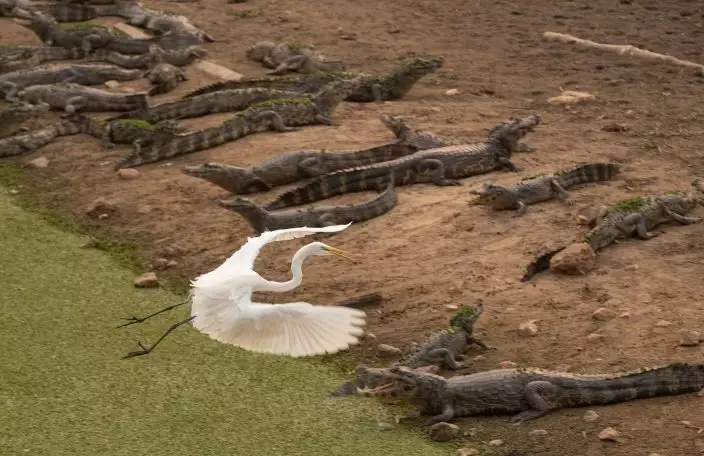
An egret flies over a bask of caiman on the banks of the almost dried up Bento Gomes river, in the Pantanal wetlands near Pocone, Mato Grosso state, Brazil, Monday, Sept. 14, 2020. The Pantanal is the world’s largest tropical wetlands, popular for viewing jaguars, along with caiman, capybara and more. This year the Pantanal is exceptionally dry and burning at a record rate. (AP PhotoAndre Penner)
One pilot said the mission was delayed because those in charge wanted to wait for the environment minister to arrive. But as panic set in, he said the planes were ordered airborne to put out fires burning bridges on the Trans-Pantanal, then told to stand down again.
Only after Environment Minister Ricardo Salles came on Aug. 18 did flights begin with some regularity, said the pilot, who spoke on condition of anonymity for fear of losing his job.
The environment ministry declined to respond to repeated requests for comment. However, a source at the Chico Mendes Institute said dropping water from planes only helps if there is ground support, which there sometimes wasn’t. Otherwise flying can be ineffective, said the source, who spoke on condition of anonymity because he wasn't authorized to speak publicly.
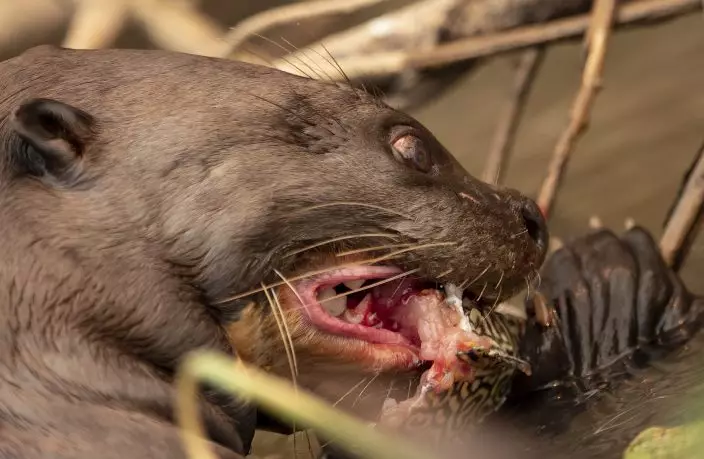
An otter chomps on a fish at the Encontro das Aguas state park in the Pantanal wetlands near Pocone, Mato Grosso state, Brazil, Saturday, Sept. 12, 2020. The Pantanal is the world’s largest tropical wetlands, popular for viewing jaguars, along with caiman, capybara, otters and more. This year the Pantanal is exceptionally dry and burning at a record rate. (AP PhotoAndre Penner)
Meanwhile, as fires raged, animals were injured, displaced or perished. Mato Grosso' firefighters and environment secretariat created a center for rescued animals.
“We try to have hope to rescue the few animals we can,” veterinarian Karen Ribeiro said after treating the injured wing of a jabiru — a massive bird that is a symbol of the Pantanal.
Dias, the SOS Pantanal director, also said volunteers have begun focusing less on fighting fires than rescuing animals, leaving fruit in places where lost creatures might find it.
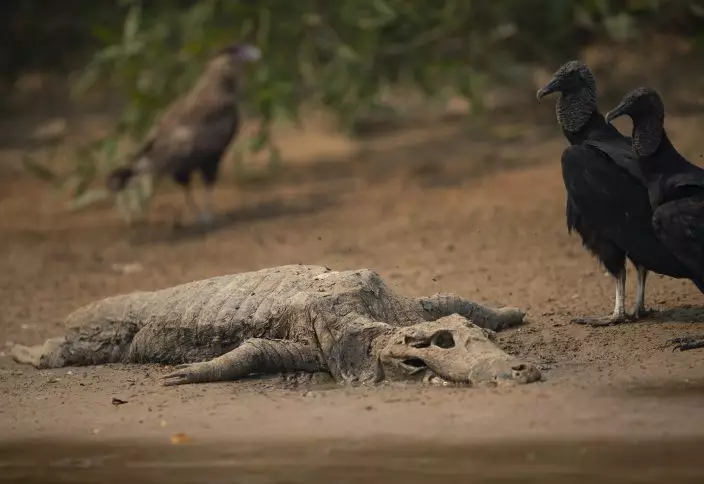
Vultures stand near the carcass of a caiman on the banks of the Cuiaba river at the Encontro das Aguas state park in the Pantanal wetlands near Pocone, Mato Grosso state, Brazil, Saturday, Sept. 12, 2020. The Pantanal is the world’s largest tropical wetlands, popular for viewing the furtive felines, along with caiman, capybara and more. This year the Pantanal is exceptionally dry and burning at a record rate. (AP PhotoAndre Penner)
After eight hours of searching, Moura, the guide, finally found a jaguar. It was limping; likely it had burned its paws, he said. Eventually it lay down on a spot of partially burned vegetation.
Earlier this month, Brazil’s government approved 13.9 million reais (about $2.5 million) to fight the fires, though most of the money is contingent on Mato Grosso getting approval for projects before a 90-day deadline. One week ago it dispatched 43 national guard firefighters to the region.
The fresh funds and troops came almost two months after the Pantanal blazes began and shortly before rains are anticipated.
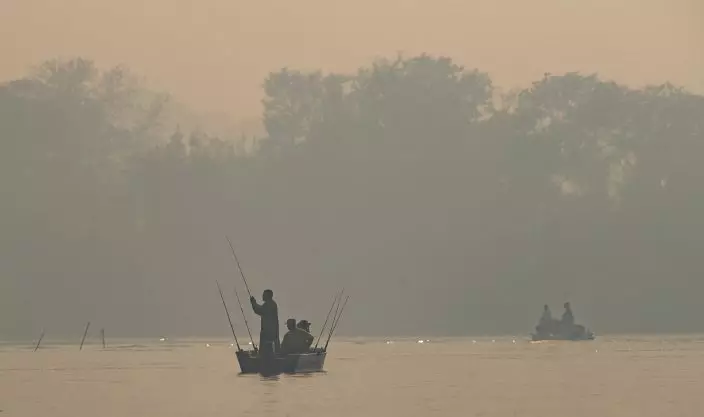
Men fish in the in the Cuiaba River in a dense smoke caused by fires, at the Encontro das Aguas state park in the Pantanal wetlands near Pocone, Mato Grosso state, Brazil, Sunday, Sept. 13, 2020. This year the Pantanal is exceptionally dry and burning at a record rate. The fires have been so intense that its smoke on Sept. 18 reached Sao Paulo, 900 miles away. (AP PhotoAndre Penner)
Moura said he doubts the money will come through in time to make any difference whatsoever.
“Unfortunately, that is the situation,” Moura said. “They act like they’re putting out the fires, and we act like we believe it.”
Biller contributed from Rio de Janeiro. Mauricio Savarese contributed from Sao Paulo.
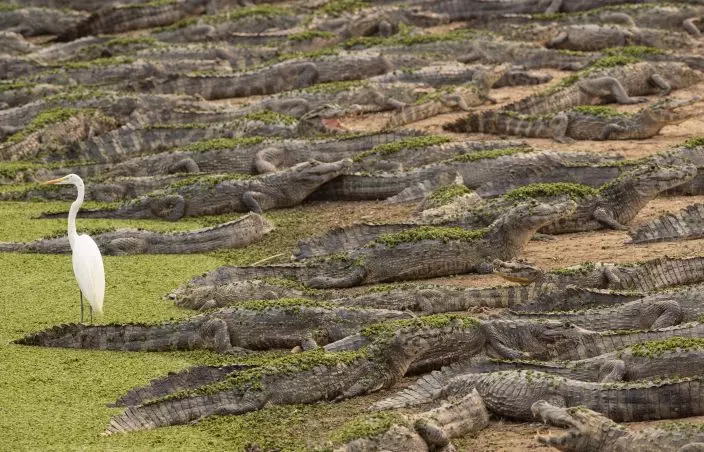
An egret flies over a bask of caiman on the banks of the almost dried up Bento Gomes river, in the Pantanal wetlands near Pocone, Mato Grosso state, Brazil, Monday, Sept. 14, 2020. The Pantanal is the world’s largest tropical wetlands, popular for viewing jaguars, along with caiman, capybara and more. This year the Pantanal is exceptionally dry and burning at a record rate. (AP PhotoAndre Penner)
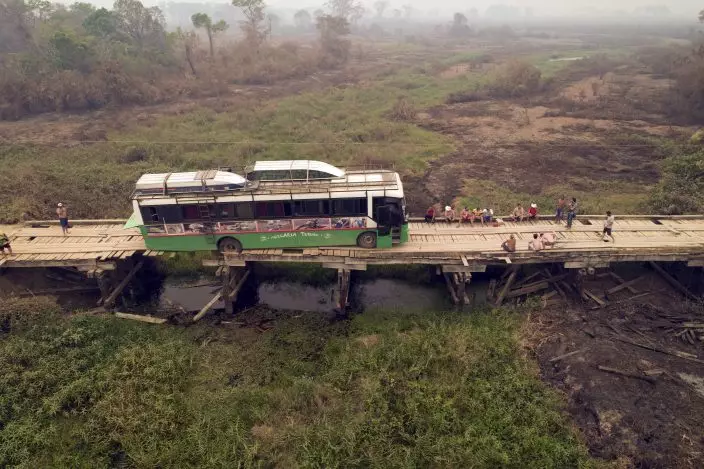
Tourists sit on a bridge railing after their sports fishing tour bus became stuck on a bridge damaged by wildfires, on the Trans-Pantanal highway in the Pantanal wetlands near Pocone, Mato Grosso state, Brazil, Friday, Sept. 11, 2020. Both sides of the highway usually feature pools of water, even in its dry season. (AP PhotoAndre Penner)

A fawn stands on the banks of the Piqueri river in the Encontro das Aguas Park near Pocone, Mato Grosso state, Brazil, Saturday, Sept. 12, 2020. The Pantanal is the world’s largest tropical wetlands, popular for viewing jaguars, along with caiman, capybara, deer and more. This year the Pantanal is exceptionally dry and burning at a record rate. (AP PhotoAndre Penner) (AP PhotoAndre Penner)
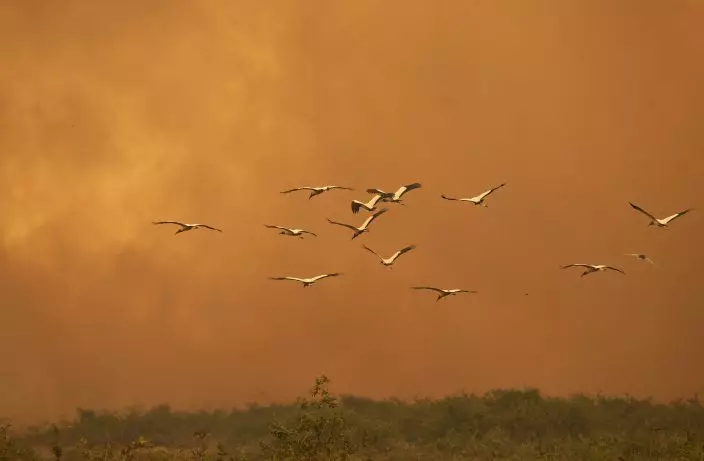
Birds fly past as a fire consumes an area next to the Trans-Pantanal highway in the Pantanal wetlands near Pocone, Mato Grosso state, Brazil, Friday, Sept. 11, 2020. As of Sept. 13, 19% of the Pantanal had been consumed by fire, according to a satellite laboratory at the Federal University of Rio de Janeiro. (AP PhotoAndre Penner)


